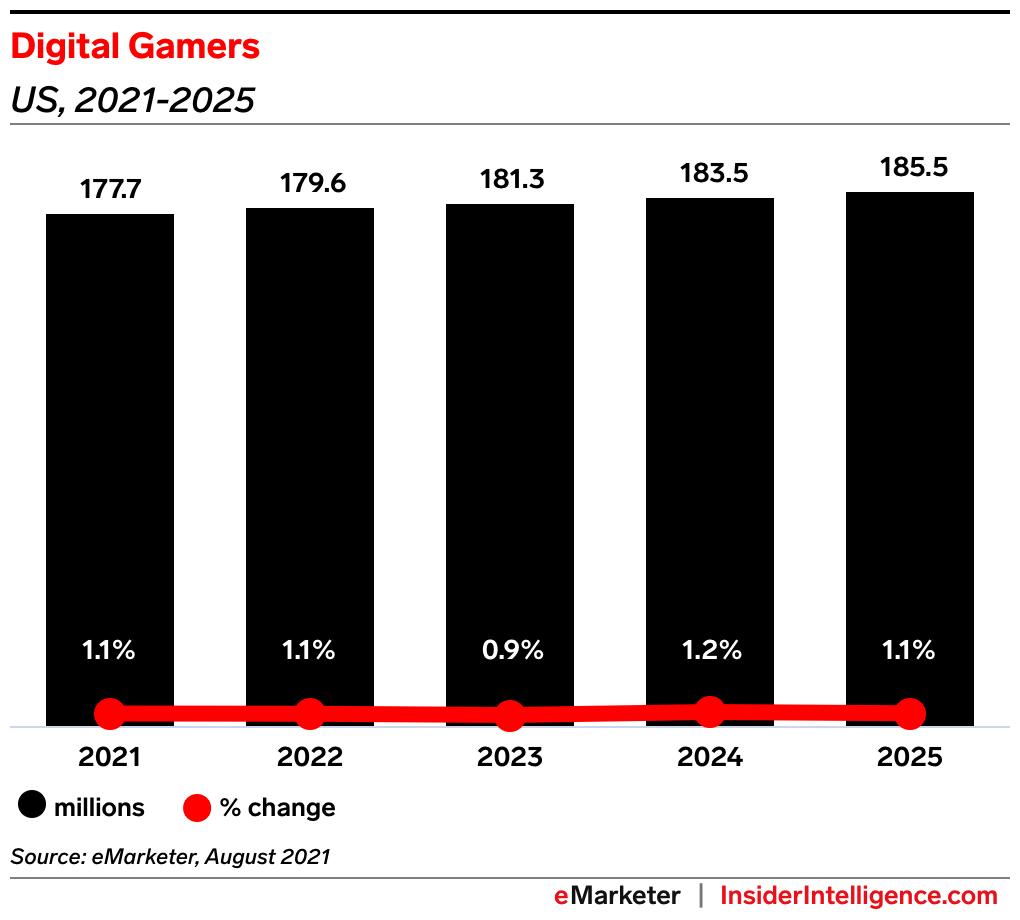- After the 2020 pandemic bump, we expect monthly digital gaming usage will see minimal growth through the end of our forecast (1.1% in 2022 and 0.9% in 2023).
- We expect the number of US digital gamers to reach 179.6 million by 2022.
- Do you work in the Marketing, Media & Advertising industry? Get business insights on the latest tech innovations, market trends, and your competitors with data-driven research.
As physical sporting events were put on hold and brick-and-mortar stores closed their doors, digital entertainment alternatives ranging from Fortnite to Animal Crossing provided consumers the ability to hone electronic communication skills and expand virtual cities and islands.

It comes as no surprise that gaming usage and viewership of gaming video content (GVC) spiked in 2020, as consumers spent more time at home and the video game industry provided a means to stay entertained and connected with friends.
But will this trend continue into 2022? Insider intelligence predicts that some of the gaming market growth will taper off in the coming year.
US Gaming Device Demographics & Trends
Gamers turned to their Nintendo, Playstation, and Xbox devices as time spent at home increased in 2020—monthly digital console gamers saw a larger increase than any other gaming device, growing by 6.3% from 2019.
Despite the rise in popularity of gaming consoles in 2020, the return to in-person work, school, and other events will cause this bump to plateau. Additionally, the way gamers play now has expanded far beyond the traditional “hard-core” narrative, of gamers who dedicate 20+ hours a week to their digital console.

Still, mobile phones are the most popular gaming device by a huge margin; there will be more than 150 million monthly mobile gamers in the US this year, amounting to over 89% of all digital gamers. The convenience of mobile gives it a leg up on all other gaming technologies simply because gamers can play on their device anywhere at any time—a quality that laptops and game consoles lack.
Other gaming platforms that serve as a happy medium between convenient mobile gaming technology and more advanced console systems are laptop and PC devices. An October 2021 survey found that 29% of US gamers played video games on a desktop or laptop.
However, it’s important to note that Insider Intelligence foresees the number of desktop/laptop gamers decreasing once the pandemic subsides, as casual gamers will likely opt to play on mobile devices and more serious gamers will continue to spend time with console devices.
Like what you’re reading? Click here to learn more about Insider Intelligence’s leading Advertising, Media, and Marketing research.
Video Game Industry Revenue
The pandemic created demand for both video game consoles and cloud gaming. In H1 2020, Nintendo reported a 73.3% year-over-year (YoY) increase in revenues, much of which were attributed to sales of the Nintendo Switch, while global cloud gaming revenue grew by nearly a billion from 2020 to 2021.
Additionally, mobile gaming market revenue increased YoY. According to December 2021 data from Sensor Tower, annual mobile game app store revenues increased over 16% YoY to $37.3 billion on Android and nearly 10% YoY to $52.3 on iOS.
US Gaming Trends and Stats
The narrative of gamers being young, tech-savvy males has shifted to a more diversified audience. As stated above, mobile gaming jumped in popularity in 2020—and because mobile and cloud gaming services have built-in social components and offer a wide variety of gaming options, they attract a more diverse audience.
There will be 179.6 million monthly gamers in the US this year—meaning more than half of the US population will identify as a digital gamer by the end of 2022.
For example, in the first six weeks after it was released in March, more than 13 million copies of Nintendo Switch’s “Animal Crossing: New Horizons,” made were sold in Japan, Europe, and the US.

However, consumers who play first-person combat-style games on devices like an Xbox or PC still skew young and male. YouGov completed a survey in 2020 to identify “hard-core” gamers—those who dedicate more than 20 hours a week to console play. Seventy-seven percent of respondents over the age of 18 identified as male compared with 23% who identified as female, and 65% of the hardcore gamers were ages 18 to 45.
Overall, there will be 179.6 million monthly gamers in the US this year—this means that more than half of the US population will identify as a digital gamer by the end of 2022. And with the rise of gamers comes an increase in viewers.
Gaming Video Content (GVC): Game Streaming Viewership Trends
Hunger for social interaction in 2020 increased the demand for game streaming, where consumers could communicate with gaming influencers and other GVC viewers.

GVC will gain more than 4 million monthly viewers through 2023—with livestream service
Twitch being the top competitor. Twitch was the most dominant platform for GVC content worldwide in Q4 2020, with 65.8% of total hours watched, compared with 23.3% for YouTube Gaming and 10.9% for Facebook Gaming.
Esports Viewership Trends
Esports is a subset of GVC content and is defined by Insider Intelligence as organized gaming competitions among professional players and teams. While in-person sporting events were delayed for months due to the pandemic, esports continued with online tournaments—allowing it to gain media coverage and viewers.
Overall, there will be more than 29.6 million monthly US esports viewers in 2022, amounting to over 49.9% of all GVC viewers.
Video Gaming Industry Forecast for 2022
Gaming market revenue is well-positioned due to the massive bump in monthly digital gamers—In 2021, consumers spent a massive $44 billion in gaming software and services. But this growth won’t last too long, as monthly digital gamers are expected to increase by just 1.1% in 2022.
With more than half of the US population already being monthly gamers, there’s limited room for further growth, and much of the audience that gaming captured amid the pandemic may lose interest once more social distancing restrictions are lifted.

One element of gaming that will remain important in 2022 is its ability to provide social interaction in a virtual way. The ability to connect with others during the pandemic elevated the social aspects of gaming across all devices, especially mobile.
While interest in connecting with people through video games may recede as the pandemic subsides, Insider Intelligence expects the social element of gaming will continue to attract a larger audience to the ecosystem through 2022 and beyond.



